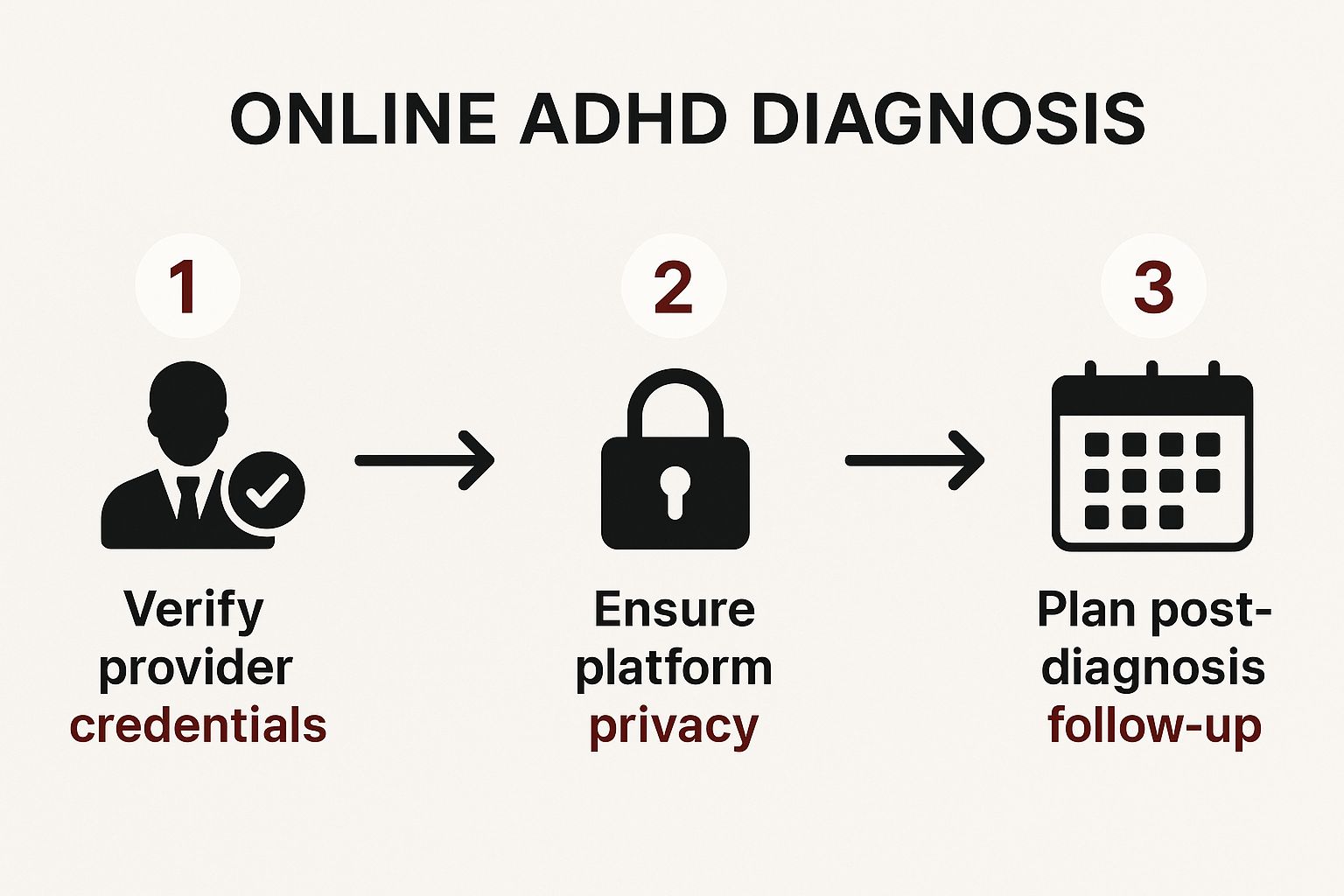Understanding Your Online ADHD Diagnosis Options
Getting an ADHD diagnosis online is becoming increasingly common. This approach offers convenience and accessibility, especially for those facing challenges with traditional healthcare. However, it’s essential to understand the different online pathways to ensure you choose a reliable and effective option. This section will help you navigate these choices and clarify the online ADHD diagnosis process.
Types of Online ADHD Assessments
Online ADHD assessments generally fall into two categories: screening tools and comprehensive diagnostic assessments. Screening tools, which are often free or low-cost, provide a quick overview of potential ADHD symptoms. These tools can be a helpful starting point, but they do not offer a diagnosis. Think of them as a preliminary checklist, highlighting areas that require further investigation.
Comprehensive diagnostic assessments, conversely, are conducted by licensed professionals and involve a more thorough evaluation. These assessments typically include interviews, questionnaires, and reviews of personal history. They can lead to a formal diagnosis if appropriate. You might be interested in: Understanding AuDHD, Autism, and ADHD.
Choosing the Right Online Provider
Not all online ADHD providers are the same. Choosing a provider with the right credentials, such as licensed psychologists, psychiatrists, or clinical social workers specializing in ADHD, is crucial. Look for platforms that prioritize data privacy and adhere to established clinical guidelines.
Transparency in pricing and the assessment process is also essential for informed decision-making. Consider whether the provider offers follow-up care, such as therapy or medication management, since receiving a diagnosis is just the first step.
The Rise of Telehealth for ADHD
The landscape of ADHD diagnosis and treatment has changed significantly with the growth of telehealth, a change accelerated by the COVID-19 pandemic. The use of telehealth for ADHD has become remarkably common.
Over the past few years, telehealth services for diagnosing and treating ADHD have increased dramatically. In the United States, almost half of adults with ADHD – around 46% – have used telehealth services for their condition. According to a CDC report, roughly one in eleven adults (8.9%) with ADHD received their diagnosis exclusively through telehealth. Another one in ten (9.5%) received their diagnosis through a combination of in-person and virtual visits. This increasing acceptance highlights telehealth’s potential to make ADHD diagnosis more accessible.
The Truth About Online ADHD Assessment Accuracy
Can you really receive an ADHD diagnosis online? Many are skeptical, often comparing online assessments unfavorably to traditional, in-person evaluations. However, recent research indicates online ADHD assessments can be surprisingly accurate, sometimes even outperforming traditional methods in specific areas.
How Reliable Are Online ADHD Assessments?
The key to trusting any ADHD assessment, whether online or in-person, is validity. A valid assessment accurately measures what it intends to measure. For ADHD, this means pinpointing the presence and severity of symptoms.
This isn’t subjective; it’s determined by comparing results to established diagnostic criteria and other validated measures. Think of two thermometers: one consistently reads five degrees higher than the actual temperature, while the other is accurate. The accurate thermometer is valid. Similarly, a valid ADHD assessment reflects an individual’s true symptom profile. Studies are showing promising results in validating online ADHD assessment tools.
Online tools for diagnosing ADHD in adults have shown impressive accuracy compared to traditional clinical interviews. A 2025 Mentavi Health study presented at an international ADHD conference revealed their online assessment tool had 78% diagnostic agreement with clinical interviews. It also achieved a Positive Predictive Value (PPV) of 94.9%.
Remarkably, the study found the online tool more accurate in identifying ADHD-positive cases than the clinical interview, with a false positive rate of only 12% compared to 56% for the clinical interview. This suggests online assessments can be valuable for accurately identifying individuals with ADHD.
Understanding the Metrics of Accuracy
Evaluating the validity of online assessments relies on key metrics:
- Sensitivity: This measures how well the assessment correctly identifies individuals with ADHD. A highly sensitive test will have few false negatives.
- Specificity: This measures how well the assessment correctly identifies individuals without ADHD. A highly specific test will have few false positives.
- Predictive Values: These indicate the probability that a positive or negative result accurately reflects a person’s true ADHD status.
These metrics offer a comprehensive view of an assessment’s accuracy, going beyond simply comparing it to another method. By evaluating these metrics, we can gain confidence in the reliability of online ADHD diagnoses.
Limitations and Further Testing
While online ADHD assessments are promising, they have limitations. They can’t entirely replace a full clinical evaluation, particularly with co-occurring conditions or complex ADHD presentations.
In these cases, further testing, like neuropsychological assessments or in-person evaluations, may be needed for a complete understanding. Choosing a reputable online platform emphasizing clinical rigor and employing licensed professionals is crucial for a trustworthy diagnosis.
Your Step-By-Step Path To Getting Diagnosed With ADHD Online
Ready to pursue an online ADHD diagnosis? This guide provides a clear roadmap, walking you through each stage of the process. From researching reputable platforms to preparing for your virtual consultation, we’ll cover the crucial steps to a successful online diagnosis.
Finding the Right Platform and Provider
First, research different online platforms offering ADHD assessments. Look for platforms with licensed professionals, such as psychologists, psychiatrists, or clinical social workers specializing in ADHD. Transparency in pricing and clear explanations of the assessment process are essential. Also, ensure the platform prioritizes data privacy and adheres to established clinical guidelines. For additional information on treatment options, consider reading about CBT for ADD/ADHD.
Preparing for Your Virtual Consultation
Once you select a platform, gather necessary information. This includes your medical history, any prior mental health evaluations, and a list of your current medications. Set up a quiet, comfortable space for your virtual consultation. This minimizes distractions and ensures a smooth, productive experience. Check your internet connection and test any required software beforehand. This helps prevent technical issues during your appointment.
During the Assessment
The assessment typically involves questionnaires, interviews, and a review of your provided information. Be open and honest with the provider about your symptoms and experiences. This helps them accurately assess your unique situation. Don’t hesitate to ask questions about the process or voice any concerns you may have.
After the Assessment
Following the assessment, the provider will explain the results. They will discuss any potential diagnoses, including ADHD. If diagnosed with ADHD, they will collaborate with you to create a personalized treatment plan tailored to your specific needs. This might involve medication, therapy, or a combination of both. Discussing any questions you have about the diagnosis or the proposed treatment plan with your provider is essential.
To help you choose an appropriate online platform, we’ve compiled a comparison table outlining key features and services.
Introducing the “Online ADHD Diagnosis Platforms Comparison” table, designed to highlight key features, costs, and services:
| Platform | Assessment Type | Cost Range | Timeline | Follow-up Care |
|---|---|---|---|---|
| Sachs Center | Comprehensive evaluation (self-report questionnaires, clinical interview) | $790-$890 | 1 week | Resources, medication management, therapy referrals |
| Sachs Center | Comprehensive evaluation (self-report questionnaires, clinical interview) + REPORT | $1190-$1290 | 1 week | Resources, medication management, therapy referrals |
| Other Centers | Comprehensive evaluation (self-report questionnaires, clinical interview) + REPORT | $4500-$6500 | 5 weeks | Medication management, personalized therapy plan |
This table provides illustrative examples. Actual costs and services may vary depending on the specific platform and provider.
As shown in the table, different platforms offer various assessment types, cost ranges, and follow-up care options. Be sure to research and choose the platform that best meets your needs and budget.
Key Considerations for Online ADHD Diagnosis
This infographic highlights three crucial considerations: verifying provider credentials, ensuring platform privacy, and planning post-diagnosis follow-up. Confirming credentials assures you’re working with a qualified professional. Protecting your privacy is paramount in any healthcare interaction. Planning follow-up care ensures you receive the necessary support after diagnosis. Getting diagnosed with ADHD online can be a valuable process if approached correctly.
Who Benefits Most From Online ADHD Diagnosis
Online ADHD diagnosis offers a new way to understand and manage this neurodevelopmental condition. But it isn’t the perfect solution for everyone. This section explores who might find online diagnosis particularly helpful and why it’s becoming increasingly popular.
Advantages for Specific Groups
Online ADHD diagnosis offers significant accessibility benefits for people in rural areas who may not have local access to specialized mental health professionals. Removing geographical barriers connects individuals with qualified providers, no matter their location. Similarly, busy professionals often struggle to schedule traditional in-person appointments. Online assessments offer the flexibility to complete the process at their own pace and convenience.
Another advantage is the comfort it provides for those who experience anxiety in traditional clinical settings. The familiar environment of home can create a sense of ease, potentially leading to a more accurate and productive assessment.
Global Accessibility and Growing Awareness
The increasing prevalence of ADHD globally has driven development in online diagnostic tools, particularly in areas with growing mental health awareness. By 2025, an estimated 404 million adults worldwide are projected to have ADHD, with approximately 16.13 million of those diagnosed adults residing in the United States. Find more detailed statistics here.
Interestingly, adults under 50 are considerably more likely (84.5%) to receive a diagnosis compared to those over 50 (51.2%). This suggests that increased awareness and better access to digital resources are contributing factors. This difference highlights the importance of accessible diagnostic options like online platforms.
When In-Person Assessment Is Recommended
While online ADHD diagnosis has its advantages, some individuals may still benefit from traditional in-person assessments. Those with complex medical or psychiatric histories, for example, may require a more thorough, in-person evaluation. This is especially relevant if other conditions are present, as these can complicate diagnosis.
Additionally, individuals with significant sensory sensitivities may find the controlled environment of a clinic more suitable for an accurate assessment. Ultimately, the best approach depends on your individual circumstances and preferences. Consider your comfort level, logistical needs, and any other health conditions when making your decision.
What Actually Happens During Your Virtual Assessment
Feeling a little anxious about an online ADHD assessment? That’s perfectly understandable. It’s natural to wonder what the process entails. This section clarifies each step, from the initial questionnaires to the live video consultation with a qualified healthcare provider, helping you feel prepared and confident.
Preparing for Your Virtual ADHD Assessment
A smooth and productive online ADHD assessment starts with a few key preparations. Initially, you’ll likely complete some detailed questionnaires. These questionnaires collect information about your symptoms, behaviors, and personal history. This helps the healthcare provider build a comprehensive picture of your experiences.
Next, set up a comfortable and private environment for your video consultation. Choose a quiet space free from distractions where you can speak openly and honestly. Make sure your internet connection is reliable and test any necessary software or apps in advance to avoid technical glitches.
Finally, gather any relevant documents, such as past medical records or educational reports. Having these readily available will streamline the process. Think of it as preparing for an important meeting – a little organization goes a long way.
The Virtual Consultation: What to Expect
During your virtual consultation, you’ll connect with a qualified healthcare provider through a video call. This is your opportunity to discuss your symptoms and experiences in detail. The provider may ask about your childhood, your current struggles, and how ADHD is impacting your daily life.
This consultation is a two-way conversation. Feel free to ask questions about the process, seek clarification on anything that’s unclear, and share any concerns you might have. Open communication is vital for a successful assessment. The provider will use this time to assess your symptoms using established diagnostic criteria for ADHD. Observing behavior and communication patterns through the video call is an important part of the evaluation process.
Next Steps and Follow-Up
Following the assessment, your provider will explain the results and outline the next steps. If you receive an ADHD diagnosis, they will create a personalized treatment plan. This could include medication, therapy, life skills coaching, or a combination tailored to your specific needs. They might also recommend connecting with other providers within The Sachs Center’s network. This could include joining online social skills programs or adult neurotribes for additional support.
If further testing or follow-up appointments are necessary, your provider will discuss those options. For example, they may suggest a neuropsychological evaluation for academic accommodations or if learning disorders are suspected. Getting an ADHD diagnosis is a journey, and maintaining open communication with your provider will ensure you receive the appropriate support and resources along the way.
Navigating Costs, Insurance, and Your Next Steps After Diagnosis
Receiving an ADHD diagnosis online is a significant step. It marks the beginning of a journey toward understanding and managing your ADHD. This next phase involves understanding the financial aspects, using your insurance, and planning practical steps to manage your ADHD effectively. Let’s explore these crucial elements.
Understanding the Costs of Online ADHD Diagnosis
The cost of an online ADHD diagnosis varies based on the platform and services you select. Initial assessments typically fall within the
$400 to $2000 range.
Additional factors like follow-up appointments, medication management, and therapy contribute to the total expense.
However, online diagnoses are often more affordable than traditional, in-person evaluations. This makes them accessible to a wider range of individuals seeking to understand their symptoms and find the right support. This increased accessibility is a key benefit of the online format.
Maximizing Insurance Benefits
Many insurance plans now cover telehealth services. This includes online ADHD assessments. Check with your insurance provider to understand the specifics of your coverage. Some plans might have pre-authorization requirements or cover only certain providers. Verifying these details in advance is crucial. Being proactive can significantly reduce out-of-pocket costs.
Managing Out-of-Pocket Expenses
Even with insurance coverage, some expenses might not be fully covered. In such cases, explore different payment options. Payment plans, flexible spending accounts (FSAs), or health savings accounts (HSAs) can be valuable tools for managing these costs. Prioritizing essential services, such as the initial assessment and medication management, helps you budget effectively. This allows you to address your most immediate needs. Read also: How to manage rejection sensitive dysphoria (RSD).
Transitioning from Diagnosis to Treatment
After receiving your online diagnosis, the next step is creating a treatment plan. This plan often involves medication management, therapy, or a combination of both. Many online platforms offer these services, ensuring a smooth continuation of care. If you prefer in-person options, your online provider can connect you with local therapists or psychiatrists specializing in ADHD.
Securing Documentation and Accommodations
A formal ADHD diagnosis is often necessary for securing accommodations in academic or workplace settings. Your online provider should provide the necessary documentation outlining your diagnosis and recommended accommodations. This documentation is essential for advocating for your needs and accessing support systems within these environments.
Building a Long-Term ADHD Management Plan
Receiving an online ADHD diagnosis isn’t a one-time event. It’s the first step toward long-term management. Develop a comprehensive plan that includes strategies for managing symptoms. This could involve building support networks, setting achievable goals, incorporating lifestyle changes, adopting mindfulness practices, or joining support groups.
To help you understand potential costs, we’ve provided a table outlining typical expenses associated with diagnosis and treatment:
ADHD Diagnosis And Treatment Costs Breakdown: Detailed breakdown of costs for online ADHD diagnosis, medication, and ongoing treatment options
| Service | Typical Cost Range | Insurance Coverage | Payment Options | Additional Notes |
|---|---|---|---|---|
| Online ADHD Assessment | $400-$2000 | Varies, check with your provider | Payment plans, FSA/HSA | May include follow-up consultations |
| Medication Management | $150 – $500 per month | Often covered, but co-pays may apply | Payment plans, FSA/HSA | Cost varies by medication |
| Therapy | $175 – $500 per session | Varies, check with your provider | Payment plans, FSA/HSA | Frequency of sessions can impact cost |
Keep in mind these are general estimates. Actual costs will vary based on the specific provider and your location. Understanding these financial and practical aspects will help you navigate your journey after diagnosis. With a proactive approach, you can confidently build a fulfilling life while effectively managing your ADHD.
Making Your Online ADHD Diagnosis Journey Count
Your online ADHD diagnosis is a significant step toward better self-understanding. This section offers strategies to maximize your virtual diagnosis experience and prepare for long-term success. It’s all about informed decisions and taking charge of your ADHD journey.
Advocating for Yourself Effectively
A successful online diagnosis hinges on advocating for your needs. This means preparing for appointments, asking clarifying questions, and voicing any concerns. For example, if anything seems unclear during the assessment, don’t hesitate to ask your provider for more information.
This proactive approach ensures the most accurate and personalized assessment. If you disagree with the initial results, know your options for a second opinion or further evaluation. Your voice is essential in this process.
Building a Strong Therapeutic Relationship, Even Virtually
Even online, a strong therapeutic relationship with your provider is crucial. Open communication is key. Honestly share your symptoms and experiences, and don’t be afraid to ask questions.
This fosters collaboration, allowing you and your provider to develop a treatment plan tailored to your needs. This could involve therapy, medication, or a combination. It’s about building a partnership for your long-term well-being.
Managing Your Diagnosis and Transitioning to Local Care
After your online diagnosis, keep your records organized and accessible. This includes the diagnostic report, treatment plan, and any other relevant documents.
This organization will be invaluable if you transition to local care. Having readily available records streamlines the process and gives your new provider a complete history. Your diagnosis empowers you to make positive lifestyle changes. Understanding your ADHD helps you improve yourself and build a more fulfilling life.
Practical Tips for a Successful Journey
- Thorough Research: Choose a reputable online platform with licensed professionals specializing in ADHD.
- Preparation is Key: Before your consultation, gather necessary information like medical history and current medications.
- Active Participation: Actively engage in your virtual assessment and ask questions.
- Organized Record-Keeping: Maintain organized records of your diagnosis and treatment plan.
- Self-Advocacy: Communicate your needs effectively with your provider.
- Transition Planning: If needed, plan a smooth transition to local care with accessible records.
A diagnosis isn’t the end, but the beginning. It’s a chance for growth, understanding, and positive change.
Ready to take control of your ADHD journey? The Sachs Center offers comprehensive telehealth-based diagnostic assessments and personalized treatment plans for children, teens, and adults. Start your journey with The Sachs Center today.
Article created using Outrank



